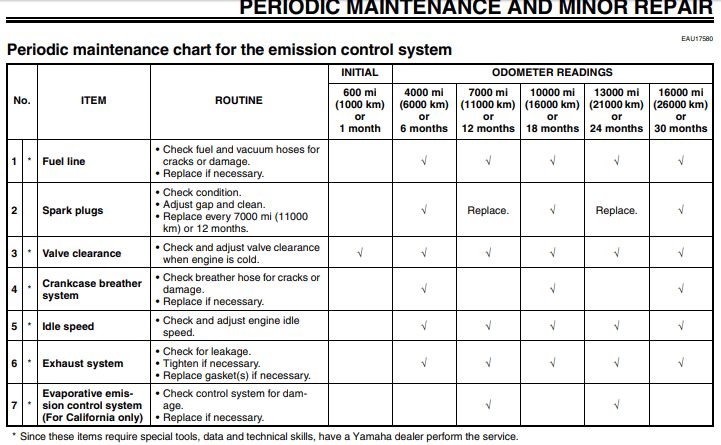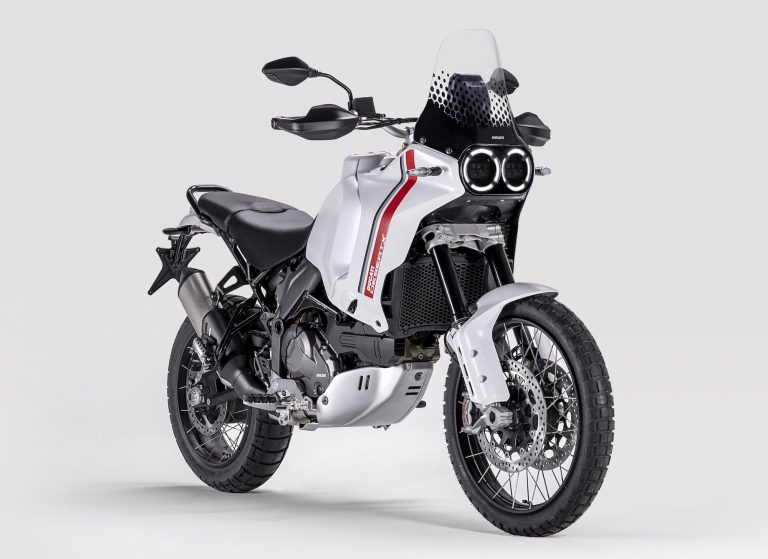Yamaha V Star 250 (XV250) Maintenance Schedule and Service Intervals
This is the maintenance schedule and associated service intervals for the Yamaha V Star 250, also known as the XV250.
The Yamaha V Star 250 is a very old-school bike, with old components, but with a modern visual design.
The modern V Star 250 is functionally identical to the one released in 2008, which was heavily based on the earlier Virago 250. You can see that maintenance schedule — it’s essentially identical, but on a separate page because people will go looking for their Virago! Even in 2021, the V Star 250 is still carburettor-fed. Quite the dinosaur. But it works.
So this maintenance schedule applies to the V Star 250 (XV250) from 2008 onward, through to 2021 and for the foreseeable future until it’s discontinued.
The V Star 250 has (and always has had) a 249cc air-cooled V-twin engine that produces… well, it’s not about how much power. It’s the fact that it’s a super cool looking V-twin that anyone can ride.
This site has links for things like oil and spark plugs from which we earn a commission (which unfortunately nobody can save, not even us). If you appreciate this work, then please use those links. Thanks!
Yamaha V Star 250 Service Intervals
The service intervals for the Yamaha V-Star 250 are every 4000 miles or 7000 km, or every 6 months.
At every service, Yamaha requires you to change the engine oil and to check or replace the spark plugs.
Yamaha also wants you to check and adjust the valve clearances at every service, which can be a bit of a chore for what’s otherwise a fairly simple everyday commuter. However, there are only two cylinders, and only two valves in each one.
Otherwise, keep the brake fluid fresh and maintain the drive chain, and you’re golden.
What you need to service the V Star 250
Firstly, you need some basic motorcycle maintenance tools. But aside from that, you also need
| Product | Description |
|---|---|
| Oil | The manual suggests Yamalube 10W-40 or Yamalube 10W-50 (if you ride in heat over 100F/40C). You need 1.4L without changing the oil filter, or 1.6L with changing it, so one gallon/4L should be good for two changes. Tighten the oil drain bolt to 34 Nm (25 ft-lb). |
| Oil filter | Replace the oil filter every time you change the oil. Standard Yamaha part is 5JX-13440-00-00, or you can use a HF145. Tighten to 10Nm (7.2 ft-lb). The benefit of the K&N is you don’t need a special tool to remove it (you can use a regular wrench). |
| Spark plugs | Use NGK spark plugs with code C6HSA (sold individually). Make sure they’re gapped to 0.6-0.7mm with an appropriate spark plug gapping tool, and tightened to 13 Nm (9.4 lb-ft) with an appropriate torque wrench. |
| Air filter | Standard Yamaha part number is 2UJ-14451-00-00. You can also use the K&N part YA-2588 which is more available. |
| Chain lube | Motul chain paste is a highly-regarded chain lubricant to use on the chain (the V Star 250 doesn’t have a belt, unlike nearly all its bigger siblings). You might also need a chain cleaner brush. |
| Brake pads | The front brake pads have parts code 4HM-W0045-00-00, and the rear brake shoes have parts code 19D-W253E-00-00. |
| Brake Fluid | You can use any DOT 4 brake fluid (the one we recommend is a high-grade synthetic one) |
Yamaha V Star 250 Maintenance Schedule
Below is the maintenance schedule for the Yamaha V Star 250.
Notes:
- At the end of the stated maintenance schedule, keep following it in the pattern shown.
- Where there’s a time and a distance-based interval (i.e. most items), follow the earlier of the two.
- Yes, the manual requires checking the valve clearances every 4000 miles / 6000 km.
| mi x 1000 | 0.6 | 4 | 8 | 12 | 16 | 20 | |
|---|---|---|---|---|---|---|---|
| km x 1000 | 1 | 7 | 13 | 19 | 25 | 31 | |
| Months | 1 | 6 | 12 | 18 | 24 | 30 | Every |
| Change engine oil (warm engine before draining) with Yamalube 10W-40 | ✓ | ✓ | ✓ | ✓ | ✓ | ✓ | |
| Replace engine oil filter (HF145) | ✓ | ✓ | ✓ | ||||
| Check spark plugs. Adjust gap and clean. Replace (R) periodically (C6HSA) | ✓ | R | ✓ | R | ✓ | ||
| Check and adjust valve clearance when engine is cold. | ✓ | ✓ | ✓ | ✓ | ✓ | ✓ | |
| Check and adjust engine idle speed. | ✓ | ✓ | ✓ | ✓ | ✓ | ||
| Clean air filter with solvent. Replace if necessary (YA-2588) | ✓ | ✓ | ✓ | ✓ | ✓ | Clean / replace more often if riding in dust/wet. | |
| Check fuel and vacuum hoses for cracks or damage. Replace if necessary. | ✓ | ✓ | ✓ | ||||
| Check battery specific gravity and breather hose for proper operation. | ✓ | ✓ | ✓ | ✓ | ✓ | ||
| Check clutch operation. Adjust or replace cable. | ✓ | ✓ | ✓ | ✓ | ✓ | ✓ | |
| Check front brake operation, fluid level, and for fluid leakage. Adjust brake lever free play and replace brake pads if necessary. | ✓ | ✓ | ✓ | ✓ | ✓ | ✓ | |
| Check rear brake operation. Adjust brake pedal free play and replace brake shoes if necessary. | ✓ | ✓ | ✓ | ✓ | ✓ | ✓ | |
| Check brake hoses for cracks or damage. | ✓ | ✓ | ✓ | ✓ | ✓ | ||
| Replace brake hoses | 4 years | ||||||
| Replace brake fluid (Castrol DOT 4) | 2 years | ||||||
| Check wheel runout, spoke tightness and for damage. Tighten spokes if necessary. | ✓ | ✓ | ✓ | ✓ | ✓ | ✓ | |
| Check tire tread depth and for damage. Replace if necessary. Check air pressure. Correct if necessary. | ✓ | ✓ | ✓ | ✓ | ✓ | ||
| Check wheel bearings for smooth operation. Replace if necessary. | ✓ | ✓ | ✓ | ✓ | ✓ | ||
| Check swingarm bush assemblies for looseness. Lubricate with lithium soap-based grease. | ✓ | ✓ | ✓ | ✓ | ✓ | ||
| Check drive chain slack, alignment and condition. Adjust and thoroughly lubricate chain (Protect all cable life) | 300 mi (500 km), or after chain gets wet/dirty | ||||||
| Check steering bearing assemblies for looseness. Moderately repack (R) with lithium soap-based grease | ✓ | ✓ | ✓ | R | ✓ | ✓ | |
| Check all chassis fitting and fasteners. Correct if necessary (tighten/replace) | ✓ | ✓ | ✓ | ✓ | ✓ | ||
| Brake lever — Apply silicone grease lightly. | ✓ | ✓ | ✓ | ✓ | ✓ | ||
| Brake pedal — Apply lithium-soap-based grease lightly. | ✓ | ✓ | ✓ | ✓ | ✓ | ||
| Clutch lever — Apply lithium-soap-based grease lightly. | ✓ | ✓ | ✓ | ✓ | ✓ | ||
| Shift pedal — Apply lithium-soap-based grease lightly. | ✓ | ✓ | ✓ | ✓ | ✓ | ||
| Sidestand pivot — Check operation. Apply lithium-soap-based grease lightly. | ✓ | ✓ | ✓ | ✓ | ✓ | ||
| Sidestand switch — Check operation and replace if necessary. | ✓ | ✓ | ✓ | ✓ | ✓ | ✓ | |
| Check front fork operation and for oil leakage. Replace or repair if necessary. | ✓ | ✓ | ✓ | ✓ | ✓ | ||
| Check rear shock operation and for oil leakage. Replace or repair if necessary. | ✓ | ✓ | ✓ | ✓ | ✓ | ||
| Check front and rear brake switch operation. | ✓ | ✓ | ✓ | ✓ | ✓ | ✓ | |
| Apply cable lubricant thoroughly (Protect All Cable Life) to control and meter cables | ✓ | ✓ | ✓ | ✓ | ✓ | ✓ | |
| Check throttle operation. Check throttle grip free play and adjust if necessary. Lubricate the throttle grip housing and cable. | ✓ | ✓ | ✓ | ✓ | ✓ | ||
| Check operation of lights, signals, and switches. Adjust headlight beam. | ✓ | ✓ | ✓ | ✓ | ✓ | ✓ | |
| Check crankcase breather hose for cracks or damage. Replace if necessary. | ✓ | ✓ | ✓ | ||||
| Check exhaust for leakage. Tighten if necessary. Replace gasket(s) if necessary. | ✓ | ✓ | ✓ | ✓ | ✓ | ||
| Check evap control system for damage. Replace if necessary. | ✓ | ✓ |
About the Yamaha V Star 250
Yamaha introduced the V Star 250 in 2008. It replaced the Virago 250, but it’s essentially the same bike in terms of specs.
Yamaha places the V Star 250 in their “Sport Heritage” group of motorcycles. Loosely speaking, this is a group of bikes that looks like the bikes of days gone past.
But there’s a wide range of motorcycles in the “Sport Heritage” lineup. At the technological top of the pile, for example, there’s the 2022 Yamaha XSR900, which has an all new engine, cruise control, and cornering abs via a 6-axis IMU. It qualifies as “heritage” because of its round headlight.
So the Yamaha V Star 250 is actual heritage. It has a very old engine design — air cooled, 2-valves per cylinder, and fed by carburettors.
Final drive on the V Star 250 is via a 5-speed transmission, so people downsizing will often be searching for that final gear. Braking is via a 282mm single front disc and a rear brake drum, and the rear shocks are mercifully adjustable for preload.
But the package still works.
The Yamaha V Star still an ultra light and nimble cruiser with enough torque to get around town, and a nice low seat to help keep your feet on the ground. And the best part is it only kept getting better looking over time — every time I see a 2020 model I do a double take, thinking “wow, nice looking bike”.
The V Star 250 is a good entry-level bike and with a 249 cc engine that has fuel economy rated at 78 mpg (3 L per hundred kilometers). So it’s an economically sound cruiser that will serve you for many years.
In 2012, there was a minor redesign that changed the shape of the 2008 handlebars and mirrors. You can see the change in the two pictures below.
- 2008 V Star 250 with high buck horn handlebars
- 2012 V Star 250 with sleeker profile
Servicing the V Star 250 is easy, but the complication is that there’s a mandatory valve service every 4000 miles (6000 km) per the US manual, or 10000 km (6000 miles) in the metric manuals.
There are only two valves per cylinder, but it’s a V-twin — so access to the cylinders isn’t quite as easy as an upright single (or twin). And there are two heads.
Manual for the Yamaha V Star 250
The above information was gleaned from the owner’s manual for the Yamaha V Star 250 from 2019, with edits and inputs from earlier models since 2008.
You can download it from Yamaha’s website here.
























